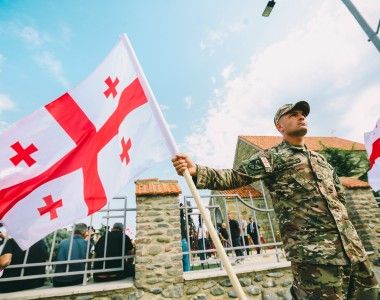CEPA: Poland Needs Defence Industrial Cooperation With US
It was a spectacular sight. Exactly 72 years and a day since their famed jump on D-Day, parts of the U.S. 82nd Airborne Division once again parachuted into Europe. Only, instead of landing in Normandy, their new drop zone was Torun, Poland. And rather than liberating France, the American paratroopers had arrived to deter the dangerous ambitions of Russia. This is what European security in the 21st century looks like.
When the American paratroopers hit the ground in Poland, they joined 31,000 other soldiers from NATO and partner states for “Anakonda 2016.” This is one of the largest combined military maneuvers in Central Europe since Russia’s illegal annexation of Crimea. It is meant to reassure NATO’s frontline allies and send a powerful message to Russia: the West is prepared to defend its allies. And while having the 82nd Airborne on the ground in Central Europe is wildly positive, exercises like “Anakonda 2016” are only part of the solution to Poland’s post-Crimea security dilemma. Warsaw needs more than high-profile maneuvers, or even more than American firepower on its territory—although these are important. Poland needs a strategic mechanism for putting more iron into America’s pledged defend of frontline Europe in a real crisis. The question is: how?
As two of my CEPA colleagues, Jakub J. Grygiel and A. Wess Mitchell, have shown in their new book, The Unquiet Frontier: Rising Rivals, Vulnerable Allies, and the Crisis of American Power (Princeton), allies that unite their defense manufacturing industries tend to stay together when military dangers loom. This fact is not hypothetical; it’s historical. And it is as relevant for deterring today’s Russia as in the past.
In the wonky language of the Pentagon, this concept is known as “defense-industrial cooperation.” To be sure, such cooperation may never fully deter Russian aggression on its own. But when it comes to forging an obvious rationale for American intervention during a military emergency, defense-industrial cooperation is necessary and desirable. The problem, is that it’s presently missing from Poland’s strategic puzzle. This should change.
For a U.S. ally like Poland, the benefits of defense-industrial cooperation are threefold:
The first is practical, since defense-industrial cooperation would encourage the integration of military hardware and data between the U.S. and Polish armies. As seen in Afghanistan, the interoperability of equipment grants NATO allies an edge on the modern battlefield. The process of integrating high-tech defense platforms into America’s frontline armies is made easier when allies share the responsibility for manufacturing it. For this reason, defense-industrial cooperation with the United States would not only increase the combat power of Poland’s military, but streamline its integration of advanced, interoperable defense systems that could deter Russia.
The second benefit is economic, since defense-industrial cooperation acts as a spur to investments in the armed forces. By aligning the economic interests of Poland and the United States via the defense sector, leaders in Warsaw and Washington can create an enduring, economic incentive to continually bolster Poland’s combat capabilities. These investments would create jobs, spread economic opportunity, and make for a stronger Poland. That would make for a more stable Europe. Better yet, Poland could extend the up-front economic benefits of defense-industrial cooperation by exporting some of its defense manufactures to neighboring allies. This would sustain domestic jobs and create knock-on benefits to the national economy.
The final, and most important benefit is strategic. Ultimately, Poland’s defense-industrial cooperation with the United States would vastly improve the credibility of Washington’s Great Power guarantee to Warsaw. While not a substitute for U.S. boots on the ground or high-profile military exercises like Anakonda 2016, the shared production of defense hardware would create a tangible demonstration America’s physical and strategic presence in Poland. And for Poland, tangible is good. Greater still, the sharing of technology and manufacturing know-how in the defense sector would launch Poland into an elite echelon of U.S. ally—granting Poland similar status to other allies like Japan. Should an unwanted future crisis ever occur, U.S. leaders would act in their own national interests to defend Poland, rather than viewing the flare up as a problem of a distant country on the periphery of American national interests. Indeed, U.S. leaders would see Poland’s survival as existential to American interests. That is the essence of the “all-for-one and one-for-all” spirit that is enshrined in Article 5 of NATO’s Washington Treaty. It needs to take shape today.
As Polish leaders plan the next-phase of their national defense modernization program, these kinds of strategic-level considerations should be front-and-center in their calculations. Poland can gain fill in the missing piece of its strategic puzzle by pursuing closer industrial-defense cooperation with the United States. The only question that remains: will Poland reap these befits? For the sake of a stronger, more stable Europe, let’s hope the answer is yes.
Peter B. Doran is Vice President of Research at the Center for European Policy Analysis (CEPA).




